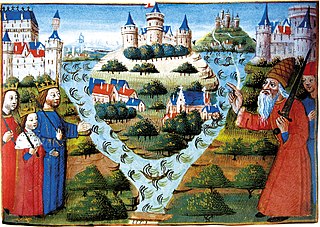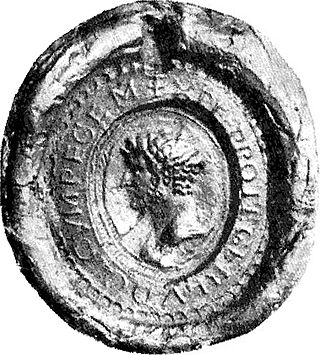Saxon conditions 838–841
During the civil war of 840–843 in the Carolingian Empire, between the heirs of Louis the Pious, the Stellinga had the support of Lothair I, who promised to grant them the rights they had had when formerly pagan and whom they in turn promised to support for the throne of East Francia. Saxony, on the eve of the Stelling uprising, was divided into two noble factions: the Saxons supportive of Hattonid influence (and thus of imperial unity) and the Saxones sollicitati, who were allied with Louis the German in his invasion of Alemannia in 839.
When Louis the Pious died, the German Louis deposed the Hattonid leader Banzleib from his royal offices and bestowed them on the Abbey of Corvey. [3] Among Louis's chief supporters in Saxony were the Ecbertiner and the Bardonids. Having patronised new families and removed from power old ones, Louis the German made the Saxon aristocracy his organ of government there and forced his foes, such as Lothair, to look to the lower classes for support in Saxony. [4]

The Saxons, sometimes called the Old Saxons, were the Germanic people of early medieval "Old" Saxony which became a Carolingian "stem duchy" in 804, in what is now northern Germany. They were the northern neighbours of the Franks and Thuringians, and the eastern neighbours of the Frisians.

The Treaty of Verdun, agreed in 10 August 843, divided the Frankish Empire into three kingdoms between Lothair I, Louis II and Charles II, the surviving sons of the emperor Louis I, the son and successor of Charlemagne. The treaty was concluded following almost three years of civil war and was the culmination of negotiations lasting more than a year. It was the first in a series of partitions contributing to the dissolution of the empire created by Charlemagne and has been seen as foreshadowing the formation of many of the modern countries of western Europe.

Louis the German, also known as Louis II of Germany, was the first king of East Francia, and ruled from 843 to 876 AD. Grandson of emperor Charlemagne and the third son of Louis the Pious, emperor of Francia, and his first wife, Ermengarde of Hesbaye, he received the appellation Germanicus shortly after his death, when East Francia became known as the kingdom of Germany.

Lothair I was a 9th-century Carolingian emperor and king of Italy (818–855) and Middle Francia (843–855).
Bernardof Septimania (795–844), son of William of Gellone and cousin of Charlemagne, was the Duke of Septimania and Count of Barcelona from 826 to 832 and again from 835 to his execution, and also Count of Carcassonne from 837. He was appointed to succeed the third Count of Barcelona, Rampon. During his career, Bernard was one of the closest counsellors of the Emperor Louis the Pious, a leading proponent of the war against the Moors, and was an opponent of the interests of the local Visigothic nobility in Iberia.

East Francia or the Kingdom of the East Franks was a successor state of Charlemagne's empire ruled by the Carolingian dynasty until 911. It was created through the Treaty of Verdun (843) which divided the former empire into three kingdoms.

The Royal Frankish Annals, also called the Annales Laurissenses maiores, are a series of annals composed in Latin in the Carolingian Francia, recording year-by-year the state of the monarchy from 741 to 829. Their authorship is unknown, though Wilhelm von Giesebrecht suggested that Arno of Salzburg was the author of an early section surviving in the copy at Lorsch Abbey. The Annals are believed to have been composed in successive sections by different authors, and then compiled.

Rorik was a Danish Viking, who ruled over parts of Friesland between 841 and 873, conquering Dorestad and Utrecht in 850. Rorik swore allegiance to Louis the German in 873. He was born in Denmark around 800. He died at some point between 873 and 882.

The Saxon Wars were the campaigns and insurrections of the thirty-three years from 772, when Charlemagne first entered Saxony with the intent to conquer, to 804, when the last rebellion of tribesmen was defeated. In all, 18 campaigns were fought, primarily in what is now northern Germany. They resulted in the incorporation of Saxony into the Frankish realm and their forcible conversion from Germanic paganism to Christianity.
Harald 'Klak' Halfdansson was a king in Jutland around 812–814 and again from 819–827.
The Hattonids were an important imperial noble family in the first half of the 9th century, during the reigns of the Carolingian kings Charlemagne and Louis the Pious. They lost their position under Louis the German. They were patronised by the emperors and were enfeoffed with benefices on imperial estates. They attended empire-wide councils and were given military commands on the borders to defend the empire from Danish Vikings and Slavs.
Banzleibs was a mid-ninth-century Frankish magnate of the Hattonid family in the Carolingian Empire.
Marklo was, according to the Vita Lebuini antiqua, an important source for early Saxon history, the tribal capital of the Saxons in which they held an annual council to "confirm their laws, give judgment on outstanding cases, and determine by common counsel whether they would go to war or be in peace that year." After the conquest of old Saxony by Charlemagne in 782 the tribal councils of Marklo were abolished.
Harald the Younger was a Viking leader and a member of the Danish royal family. He has sometimes been mistakenly identified with Harald Klak, who was in fact his uncle and probable namesake. His brother was Rorik of Dorestad.
Gilbert (Giselbert), Count of Maasgau was a Frankish noble in what would become Lotharingia, during his lifetime in the 9th century. The Carolingian dynasty created this "middle kingdom" and fought over it, and he is mentioned as playing a role on both sides.

The siege of Paris of 845 was the culmination of a Viking invasion of West Francia. The Viking forces were led by a Norse chieftain named "Reginherus", or Ragnar, who tentatively has been identified with the legendary saga character Ragnar Lodbrok. Reginherus's fleet of 120 Viking ships, carrying thousands of warriors, entered the Seine in March and sailed up the river.
The Linones were a small Slavic people first recorded in the early 9th century. They lived north and east of the Elbe, across from Höhbeck in the region around Lenzen, south of the Wilzi and Obotrites, north of the Hevelli and northeast of the Saxons. They may have been a sub-group of the Wilzi and were often under Obotrite control. They may be associated with the medieval Gau Liezizi.
Adalbert was Frankish nobleman with lands scattered throughout the Carolingian Empire. He was one of the most trusted advisors of Emperor Louis the Pious. By 838, he was the count of Metz. He was strongly opposed to the ambition of the emperor's son, Louis the German, for a large kingdom in East Francia. After the elder Louis's death, he supported Emperor Lothar I and it was in the latter's service that he was killed in battle with Louis the German.
The battle of the Ries of 13 May 841 was a major engagement of the Carolingian civil war of 840–843. King Louis the German surprised and routed the army of Count Adalbert of Metz on the banks of the river Wörnitz in the Ries. Adalbert, who had been charged by the emperor Lothar I with preventing Louis from breaking out of Bavaria, was killed in the fighting. The victory allowed Louis to join up with King Charles the Bald and defeat Lothar in the battle of Fontenoy-en-Puisaye in late June.
The Carolingian civil war was a violent crisis over the succession to the Carolingian Empire following the death of Emperor Louis the Pious in June 840 and lasting until the Treaty of Verdun in August 843. Louis's eldest son, the emperor Lothar I, laid claim to an undivided empire, while his younger brothers Louis the German and Charles the Bald sought large kingdoms of their own on the basis of previous divisions planned by the late emperor. Their nephew, Pippin II, laid claim to Aquitaine.








